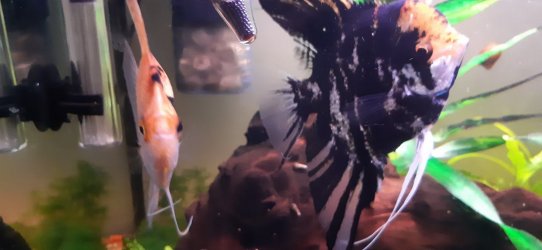Help! My angel fish has developed a sunken/hollowed head in the last week. When i first noticed it (5 days ago), it was barely noticeable but has gotten worse in the last few days. I have googled this to no end and the only thing that has come up is hexamita (hole in the head) which i don't think is what it is, as it doesn't look like the pictures of hexamita and there are no white spot/pimples that i can see which seems to be the early signs of it. It's only affected this one angelfish, and it seems healthy otherwise, eating well, and pooing fine from what i've seen.
In the tank, i have 2 angelfish and 4 cherry barbs and its a 35gal tank, (+ a few nerite snails and countless trumpet snails) I feed them a variety of different foods (pellet food, dried bloodworms and occasionally dried daphnia) do approx 30-50% water changes every two weeks, there haven't been any new additions to the tank for two years (fish, plants or otherwise). I did a water parameter check as soon as I noticed this angelfish's head looked weird and it came up as everything in the range it should be and did another just now (4 days after last water change) and everything was as i wrote below
I asked in a few of my fish groups on facebook but no one really had any certain answers. One person said it is hole in the head, another said a birth defect, one said looks like fish TB.
Symptoms: Sunken/hollowed head just above the eyes, that started on one side, has gotten worse/more noticeable and is also on the other side now too. No spots, no wounds, nothing else that i can tell. Is eating fine, is still active and swims around with my other angelfish
Tank size: 35 imperial gallons
tank age: about 3 and a half years
pH: about 6.8/7
ammonia: 0 ppm
nitrite: 0 ppm
nitrate: 0 ppm
kH: unknown
gH: unknown
tank temp: 25 celcius
Also feel important to note i had activated carbon in my filter since i've had the tank,but took it all out a few days ago after reading about hexamita as i thought thats what my fish had until i read better descriptions/saw photos of it
It's hard to get a photo but i've attached some below, the white one is the one with the weird head. The black one is fine
In the tank, i have 2 angelfish and 4 cherry barbs and its a 35gal tank, (+ a few nerite snails and countless trumpet snails) I feed them a variety of different foods (pellet food, dried bloodworms and occasionally dried daphnia) do approx 30-50% water changes every two weeks, there haven't been any new additions to the tank for two years (fish, plants or otherwise). I did a water parameter check as soon as I noticed this angelfish's head looked weird and it came up as everything in the range it should be and did another just now (4 days after last water change) and everything was as i wrote below
I asked in a few of my fish groups on facebook but no one really had any certain answers. One person said it is hole in the head, another said a birth defect, one said looks like fish TB.
Symptoms: Sunken/hollowed head just above the eyes, that started on one side, has gotten worse/more noticeable and is also on the other side now too. No spots, no wounds, nothing else that i can tell. Is eating fine, is still active and swims around with my other angelfish
Tank size: 35 imperial gallons
tank age: about 3 and a half years
pH: about 6.8/7
ammonia: 0 ppm
nitrite: 0 ppm
nitrate: 0 ppm
kH: unknown
gH: unknown
tank temp: 25 celcius
Also feel important to note i had activated carbon in my filter since i've had the tank,but took it all out a few days ago after reading about hexamita as i thought thats what my fish had until i read better descriptions/saw photos of it
It's hard to get a photo but i've attached some below, the white one is the one with the weird head. The black one is fine





